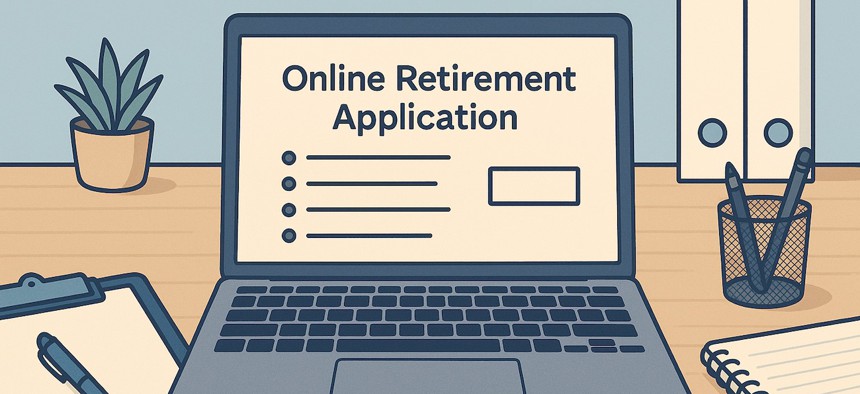
Illustration by OpenAI
OPM’s digital retirement application is live. What that means for feds planning to retire
The new electronic retirement system promises a faster, more accurate process, but some users are still adjusting to the change.
In the fall of 2019, I toured the Office of Personnel Management’s (OPM) Retirement Operations Center—known as the “ROC”—located 220 feet underground in a former limestone mine north of Pittsburgh, Pennsylvania. Federal employees work daily in this subterranean space lined with rugged silver-painted stone walls and floors packed with 22,000 file cabinets stacked 10 high. These cabinets contain 400 million civilian retirement records and have long symbolized the government’s reliance on paper-based processing. That is finally starting to change.
As noted in a previous article, the move toward electronic retirement processing has been linked to the rise of the Department of Government Efficiency (DOGE), but OPM has been working on retirement system modernization for years. After piloting the Online Retirement Application (ORA) in 2024, the agency has now rolled it out governmentwide. All new retirement applications must be submitted electronically.
In OPM’s Information Technology Strategic Plan for 2023–2026, former Chief Information Officer Guy Cavallo prioritized modernization initiatives including Electronic Retirement Records (ERR), ORA, and RS Surveys. While Cavallo retired earlier this year, those efforts are now reaching employees preparing to retire in 2025.
The modernization aims to streamline the process by digitizing retirement applications, verifying service credit eligibility, and storing retirement files electronically.
I recently spoke with an employee in the Deferred Retirement Program (DRP) who is planning to retire on Sept. 30. He shared his experience completing the new ORA.
Does the online application populate data already in your agency’s payroll system?
Yes. My name, agency, and other payroll information were pre-filled.
Can you save a partially completed application?
Yes. I was able to save my progress and return using credentials provided via email.
Can you complete the application on a personal device?
Yes. I no longer have access to my work computer, so I completed it on my MacBook using Login.gov. There were no issues.
Can you save or print the completed application?
There was a download/print button, but it didn’t work. However, my completed application is visible in my dashboard. I’m unsure whether it will remain accessible after retirement.
Note: This download feature may become available after the “Certified Summary of Federal Service” is signed. That step had not yet been completed at the time of this interview.
How do you upload supporting documents?
After completing all application sections, I was prompted to upload my marriage certificate, IRS Form W-4P, and life insurance election form SF 2818.
Was anything surprising?
Yes—the process was intuitive and user-friendly. Each section had clear white space and minimal text per screen, which made the experience easy to follow.
Tips for others?
It helped that I had already completed the paper SF 3107, the FERS Application for Immediate Retirement. Also, I stayed in contact with my HR retirement specialist, which was helpful. I recommend checking your designation of beneficiary forms (SF 3102 for retirement; SF 2823 for FEGLI). These were not included in the ORA checklist.
Dennis Damp, author of the retirement blog FederalRetirement.net, relayed a case from a recent retiree named Paul. Paul confirmed that retirees must have their non-government email submitted to the ORA portal by their agency. The email must match the one used to sign in through Login.gov. Paul reported no issues using a personal email for the entire process.
Employees are reminded to read all instructions carefully. All documentation requested—marriage certificates, DD-214s, court orders, and IRS forms—must be submitted. All retirees must include a W-4P tax form. As of 2023, the default withholding is "single with zero allowances." To opt out of federal tax withholding, employees must write “No Withholding” in Step 4(c).
In a recent press release, OPM announced that as of July 15, 2025, paper retirement applications will no longer be accepted. Agencies served by the National Finance Center (NFC) and Interior Business Center (IBC) must begin submitting applications through ORA by June 2, 2025. Some agencies have received limited extensions. The shift is expected to reduce backlogs, increase accuracy, and save taxpayer dollars.
While the exact time savings remain to be seen, much of the benefit is expected at the start of the process. According to OPM’s Retirement Quick Guide, agency and payroll processing can take 30–45 days, with OPM “intake” adding 10–15 more. ORA may help reduce errors and delays at these early stages, though complex cases may still take 90 days or more to fully adjudicate.
Common delays include:
-
Divorce decrees or court-ordered settlements
-
Service as law enforcement, firefighters, or other special categories
-
Workers’ compensation history
-
Part-time or intermittent service
-
Multiple agency work history
-
Missing or incorrect documentation
-
Address changes not reported to OPM
There’s still room for improvement, but ORA marks a significant step toward modernizing the federal retirement process.







